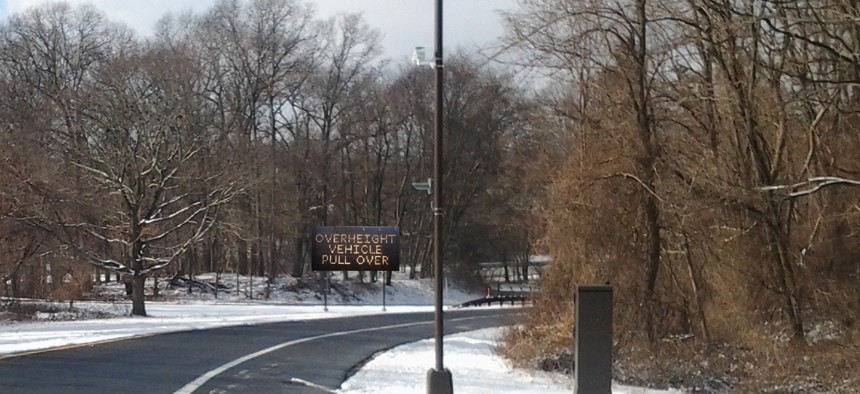New York State ‘Bridge Strikes’ Prompt New Detection Systems

An example of an over-height sign detecting a vehicle that would be too high to fit under a bridge ahead. Office of New York Gov. Andrew Cuomo
State parkways are off limits to trucks and buses. But it only takes one to cause a big traffic headache or worse.
It was a Tuesday in late October last year when a truck carrying a cargo of margarine tried to pass under the King Street bridge on the Hutchinson River Parkway . But the bridge, which is located north of New York City at the Connecticut state line, was too low.
The truck hit it and then caught fire. The driver was OK, but the crash caused grinding traffic delays that lasted for hours .
This is the type of wreck New York state is attempting to prevent with the over-height vehicle detection systems it is deploying at some entrances along the state’s parkways.
Gov. Andrew Cuomo’s office announced Thursday that the state had completed the latest detection system installations at two interchanges on the Hutchinson River Parkway, both less than 10 miles south of where the margarine truck incident took place last year.
The detection systems are just one effort that transportation agencies in New York state and New York City have adopted in recent years to cut down on so-called “bridge strikes” caused by errant operators of trucks and other over-height vehicles.
Another example is GIS and KML format map data that the New York City Department of Transportation, began releasing in 2009, which shows truck routes and low bridges in the city. The department has also piloted technology such as truck height detectors, cameras and electronic signs, according to a spokesperson.
Although commercial vehicles are barred from traveling on New York state parkways, their drivers still sometimes stray onto the roads.
New York’s master builder Robert Moses was largely responsible for the design of the parkways in and around the city and some have said that the bridges that cross over them were intentionally kept low to prevent buses, and in turn poor people, off of the roadways.
The stone arch bridges on the parkways located in the state’s lower Hudson Valley tend to have vertical clearances between 8 feet and 11 feet, according to a 2011 report on bridge strikes that the New York State DOT sponsored.
And a joint fact sheet from the New York State DOT and New York City DOT notes that some parkway bridges have clearances as low as 6 feet 11 inches.
Most states set height limits for commercial vehicles between 13 feet 6 inches and 14 feet, according to the Federal Highway Administration .
When combined with a heavy flow of out-of-state truckers, the difference between the bridge clearances and vehicle heights can lead to ugly results .
According to the New York State DOT, 164 vehicles struck bridges last year in New York City, the Hudson Valley and Long Island. More than 250 trucks traveling in New York City either illegally entered parkways or hit overpasses during 2013 and 2014, according to the city’s DOT.
The 2011 report sponsored by the state said that the King Street bridge—the one the margarine truck ran into—had been hit 62 times.
As The Wall Street Journal reported in 2012, GPS navigation technology that doesn’t distinguish between cars and trucks has contributed to many bridge strikes in New York.
The detection systems the state is installing at the parkway interchanges rely on infrared beams to identify over-height vehicles, according to Cuomo’s office. When triggered, an electronic sign flashes telling the driver to pull over and the state DOT’s Traffic Management Center is automatically alerted.
Paying for the new systems is $5 million allocated under a pilot program to reduce vehicle-bridge collisions, which the New York State Legislature and Cuomo approved in 2014.
Along with the two new detectors on “The Hutch,” those funds paid for over-height detection systems the state installed last year at three locations on Long Island’s Northern State Parkway, and will also cover the cost of a to be determined number that will be put in place on Long Island’s Southern State Parkway, according to the state DOT.
New York’s first over-height detection system became operational in 2011 on the Onondaga Lake Parkway near Syracuse, where four Megabus passengers were killed the year before when their double-decker bus crashed into a railroad bridge.
A state DOT spokesperson did not have any immediate data available to show whether bridge strikes had decreased since the system was put in place.
But as Durham, North Carolina’s infamous “ 11-foot-8 bridge ” shows, over-height detection systems don’t always prevent drivers from noticing the danger immediately ahead.
NEXT STORY: IBM opens network tech testing facilities






